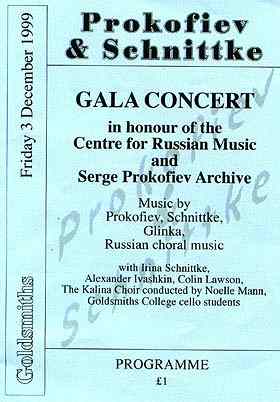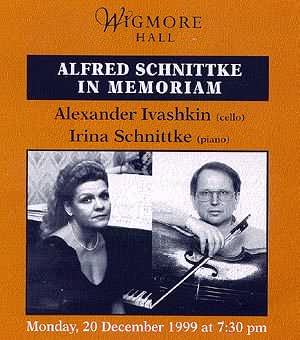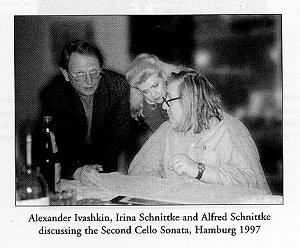 |
 |
Two auspicious events for Southeast London were linked and celebrated during
December. Alexander Ivashkin, distinguished cellist and close friend
of Alfred Schnittke, has taken up an appointment as Professor of Music and
Director of the Centre for Russian Music at Goldsmiths College (curator Noelle
Mann) and Irina Schnittke, the composer's widow and one of the finest
Russian pianists of her generation, has donated her archive of Schnittke
scores and memorabilia to the Centre for Russian Music.

On 3 December they participated in a Gala Concert at Goldsmiths, playing
together Schnittke's 1st cello sonata (1978). Despite having to
use a small, inadequate piano (Goldsmiths College desperately needs a good
concert grand) Irina Schnittke produced wonders of colour and sonority to
support her cellist partner, who gave commanding and lustrous performances
in each role, a worthy inauguration of his professorship and the good luck
of Goldsmith's in attracting so important a performing musician and academic.
Noelle Mann's locally famed Kalina Choir, devoted to promoting the rich choral tradition of Russia, and well loved for its enthusiasm in presenting that heart-warming repertoire in excellent Russian, contributed several characteristic items by Bortiniansky, Dargomyzhsky, Tchaikovsky, Prokofiev and Sviridov. Alexander Ivashkin joined Colin Lawson, clarinet, and Andrew Zolinsky, piano for Glinka's Trio Pathetique (no masterpiece, but a change from the Beethoven and Brahms trios) and he led five advanced cello students in Rostropovich's very successful arrangement of the andante from Prokofiev's unfinished Concertino Op. 132 (1952). A very happy event, presaging further opportunities at Goldsmiths to explore this fertile field (Alexander Ivashkin will be directing their Contemporary Music Ensemble at a public concert on 16 March).
The Wigmore Hall recital on 20 December was a rare opportunity to hear a body of Schnittke's instrumental music by two of its dedicatees. The first sonata plays without a break. It is polystylic, a method particularly associated with Schnittke, which stood him in good stead for the years of his greatest popularity. It inhabits the borders between major and minor, alludes to early classical music, has a motoric second movement with violent waltz episodes, and culminates with massive clusters, after which there is a long, slow finale. The shorter, more introspective second (1994) was one of Schnittke's final works before his fifth and fatal stroke. Premiered by Rostropovich with Irina Schnittke, its passionate cello monologue, only lightly accompanied, was delivered with superb control of bowing and tone colours, vibrato varied exactly as needed. There were two effective and moving short cello solos, a Madrigal in memory of Oleg Kagan and Klingende Buchstaben (1988) dedicated to Alexander Ivashkin. Irina Schnittke played the 2nd Piano Sonata (1991) dedicated to herself, and she came fully into her own on the Steinway. The Wigmore Hall acoustic made for compelling listening throughout the long recital. The audience was roused to tremendous enthusiasm (a reminder that in Russia during the 70s & 80s the police were needed to quell gatecrashers to Schnittke's concerts, which were always sold out).
The presentation was deplorable, reflected in the modest attendance for such an important recital - the Goldsmiths event earlier in the month had been featured in the R3 In Tune programme. The promoters supplied no programme notes with information about this unusual music, save for titles, dates and lists of movements. This lack of background was especially regrettable for the Epilogue for cello, piano and tape. Most people expected a short piece to end the recital, but this was a twenty five-minute meditation upon all the events in the life of Ibsen's eponymous hero, juxtaposing and overlapping themes from Schnittke's Peer Gynt ballet score. This listener was reminded at one point of John Tavener's ecstatic cello music. A pre-recorded choir creates a mystical background and the ending was a slow ascent to the heights, finishing with a glowing D major chord.
With proper organisation, many copies of Alexander Ivashkin's book on Schnittke (Phaidon Press, 1996) would have been sold after the recital, and one might have expected that Chandos would have ensured that their new CD of all Schnittke's cello and piano music, played by the same artists, would have been made available for purchase there too. It is very good indeed, so I can unreservedly recommend you to acquire it [CHAN 9705].
Peter Grahame Woolf.
 Return to:
Return to: